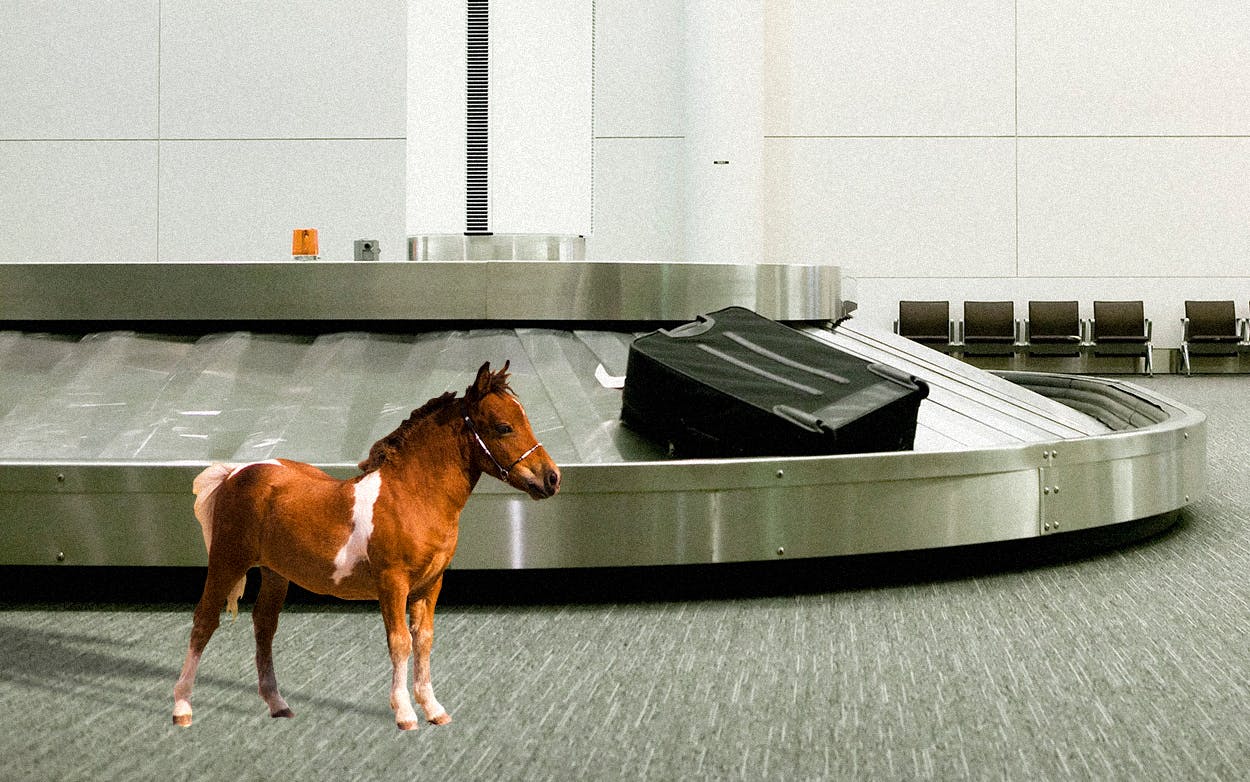On September 17, a new service animal policy from Southwest Airlines goes into effect. The new rules—which govern trained service animals, psychological support animals, and emotional support animals—largely serve as clarification about what is and isn’t allowed on a Southwest flight. But there’s one line in the streamlined policy that has caught a lot of people’s eyes: “Southwest will only accept the following species of animals in our cabin as trained service animals—dogs, cats, and miniature horses.”
Trained service dogs, sure, and we’ll get to cats in a minute. But it was the specific inclusion of miniature horses on the list that caught the attention of headline writers around the world. You probably have questions. We will answer them.
You can bring a miniature horse on an airplane now?
Yes, but it’s not actually a change of policy. The previous rules for Southwest allowed people to bring miniature horses that work as service animals on flights, it just didn’t specify the species. Previously, the rules simply stated that “unusual or exotic animals” were excluded and listed rodents, ferrets, insects, spiders, reptiles, hedgehogs, rabbits, and sugar gliders as examples of such beasts. Miniature horses in service roles are actually not uncommon, and so in more clearly outlining the policy, the airline singled them out as one of the three acceptable species.
What sort of jobs do miniature horses do?
Check out that video from Fox Detroit. Lil’ Shadow up there does everything a dog can do, plus he can pull a wheelchair, and he’s tall enough that he can serve as a support for people who’ll benefit from having an additional way to balance.
Miniature horses are still way bigger than dogs. Where do they sit on the plane?
Generally, the horses are sat near the front of the plane, at the bulkhead, which has more space than the rest of the plane. (They, like all service animals, are restricted from flying in an exit row.) A Southwest spokesperson notes that miniature horses on flights are “extremely rare,” so it’s unlikely that a flight would have so many of them onboard that the crew would need to start putting them in the aisles.
What about full-sized horses?
The Department of Transportation has pretty broad rules about what airlines must do in order to be compliant with the Americans with Disabilities Act, and it errs on the side of accessibility. However, it does not require airlines to transport animals that are too large to safely fit in their cabins, so it’s mini horses only.
Are these horses emotional support animals?
Nope. These horses must be either trained service animals or psychological support animals. Southwest’s new policy restricts ESAs to cats and dogs only.
What’s the difference between an ESA, a psychological support animal, and a trained service animal?
Good question. Contrary to popular belief, none of the above require a special certification. That said, there are distinctions: trained service animals provide specific services to people with disabilities or medical conditions, such as guiding them if they can’t see, or smelling the breath of owners with diabetes to help them identify if there are current elevated risk factors that require attention. Psychological support animals provide the same kind of immediate service to and perform specific tasks for people who require assistance because of psychological rather than physical conditions. For the purposes of Southwest’s new guidelines, those two things are identical.
Emotional support animals are a little more controversial because there are fewer guidelines establishing what they do or who requires them. Any dog or cat can be an emotional support animal if its owner has obtained a letter (which can be done online) that states that they require the animal’s support. People sometimes get these letters so they can more easily travel with their pets, which means that people who actually do need an ESA have to deal with side-eyed glances from people who assume that they’re trying to game the system.
So how do airlines know what role animals brought onto the plane fulfill?
Mostly, they ask. Southwest says that it requires “credible verbal assurance” that the cat/dog/mini horse is, in fact, working. For ESAs, they also require a letter that the person who owns the animal requires its services.
So only dogs, cats, and mini horses can be trained service animals?
According to Southwest Airlines, yeah. According to the ADA, no—but under the ADA, the term “service animal” refers only to dogs. That said, obviously other animals can be trained to perform tasks that help people with disabilities access the world.
Most of the information you’ll find online about cats as service animals suggests that they can’t serve that role. But cats can be trained to perform certain service tasks. They can’t pull a wheelchair, but people say that they’ve trained them to push a button to call 911 in an emergency or alert someone that they’re at risk of a seizure.
Can you bring a trained service miniature horse on any airline?
Yep. Southwest is the one making headlines because they singled out mini horses in their new policy, but it actually applies broadly—every airline has to conform to the Department of Transportation’s guidelines, and those guidelines identify miniature horses as common service species. So if anybody tries to stop you from bringing a miniature horse you need to perform specific tasks for your health, safety, or accessibility on a flight, they’re breaking the law.
How cute are miniature horses?








